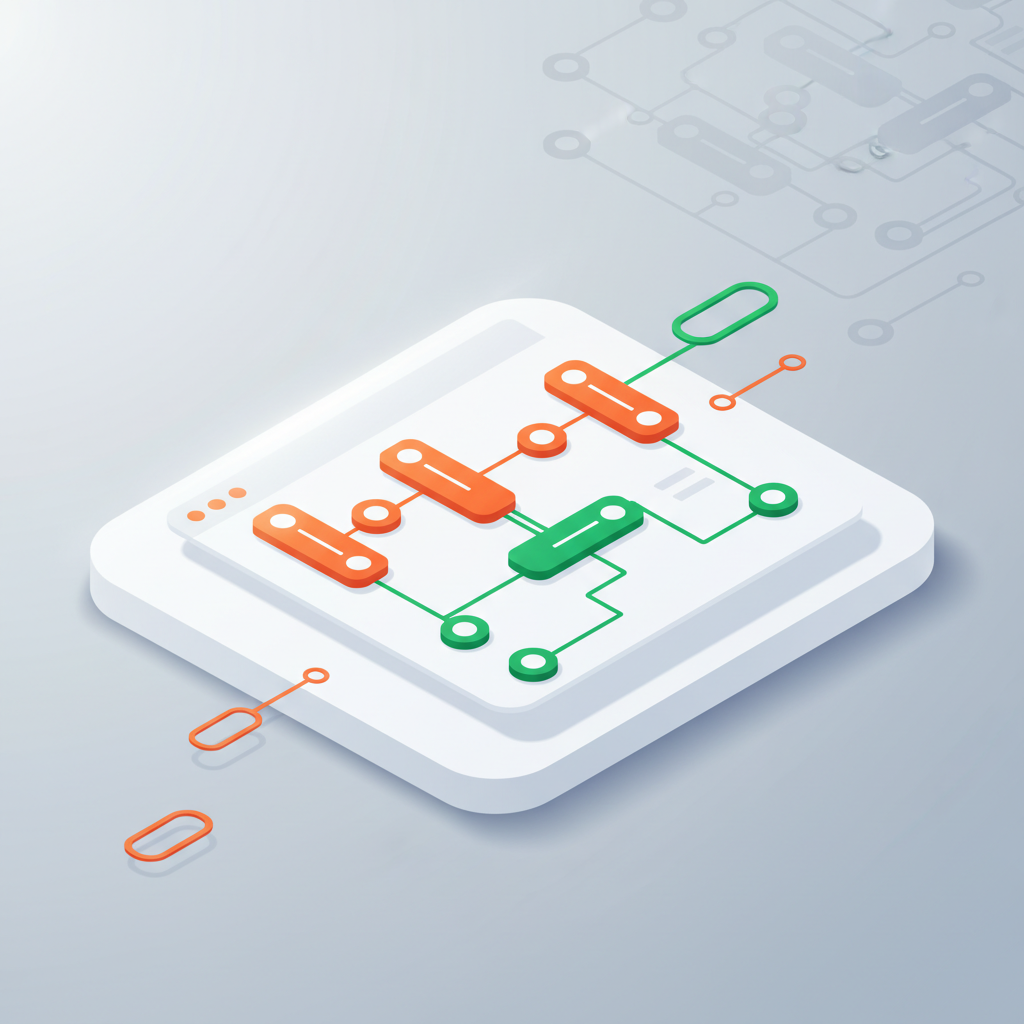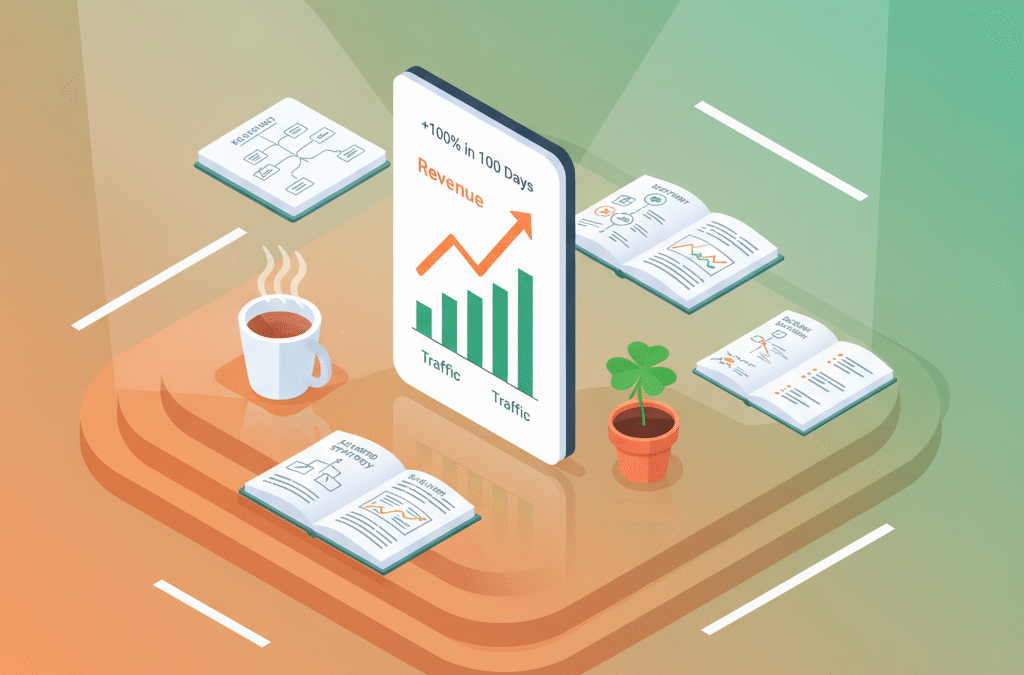Key Takeaways
- Google’s AI Overviews appear in 13% of all searches, significantly reducing organic click-through rates.
- Organic clicks can drop by up to 64% when AI Overviews are present in search results.
- ChatGPT processes 2.5 billion prompts daily, influencing a large audience of potential buyers.
- Irish ecommerce brands risk invisibility if their products are not featured in AI-generated answers.
- Understanding and adapting to AI-driven search trends is crucial for capturing organic traffic in Ireland.
Table of Contents
- Why Irish Ecommerce Brands Are Missing 64% of Their Organic Traffic
- What Ecommerce SEO Actually Means in 2025
- The 100-Day Traffic Sprint: Building Compounding Growth for Irish Shopify Stores
- Keyword Research Beyond “Best [Product] Ireland”
- Site Architecture That Sells: The 3-Click Rule and Why Most Irish Stores Fail It
- On-Page Optimization: Making Product Pages Rank and Convert
- Technical SEO Foundations: The Unglamorous Work That 10x’s Your Results
- Content Strategy Beyond Product Pages: Building Topical Authority
Why Irish Ecommerce Brands Are Missing 64% of Their Organic Traffic
Here’s what most Irish ecommerce founders don’t realize: Google’s AI Overviews now appear in 13% of all searches, cutting organic clicks by up to 64% when they do. Meanwhile, ChatGPT processes 2.5 billion prompts daily, and if your products aren’t mentioned in those AI answers, you’re invisible to an entire generation of buyers. Book a free AEO and SEO strategy call to ensure your products are visible where it matters most.
I’ve spent 18 months stress-testing what actually works for Irish DTC brands selling €500K–€5M annually. The brands thriving aren’t just optimizing for Google’s blue links, they’re dominating the entire search ecosystem, from traditional SERPs to AI answer engines like ChatGPT and Perplexity. This shift from basic SEO to what I call “Agentic SEO” is the difference between fighting for scraps and capturing compounding organic growth. If you want to understand the latest strategies, explore our blog for in-depth insights.
The opportunity is massive. Ireland’s ecommerce market continues expanding, but most competitors are still running 2019 playbooks while customer acquisition costs climb and paid ads become less predictable. The brands that adapt to AI-powered search now will own the next decade of organic visibility.
Critical Reality Check: If your Irish ecommerce site isn’t optimized for both Google’s traditional algorithm AND AI-powered answers, you’re essentially invisible to half your potential customers.
What Ecommerce SEO Actually Means in 2025

Ecommerce SEO in 2025 isn’t about stuffing keywords into product descriptions. It’s about owning the entire customer search journey from “I have a problem” to “I’m buying this solution.” Most Irish agencies are still treating product pages like blog posts, ignoring the technical commerce requirements that make or break rankings.
The fundamental shift: you now need to dominate three visibility layers simultaneously. Traditional SERP visibility gets you the blue link clicks. AI answer engine presence puts your brand in ChatGPT and Perplexity responses. Google’s commerce features surface your store ratings and product snippets directly in Irish search results.
The Three Layers Irish Brands Must Control
Layer one is traditional rankings, but Google now surfaces store ratings directly in Irish search results as of October 2024. Layer two is AI citations, when someone asks ChatGPT “best running shoes Dublin,” your brand needs to appear in that answer. Layer three is Google’s shopping graph, where your products compete in visual search and shopping ads integration.
Standard SEO agencies fail at ecommerce because they don’t understand faceted navigation, variant URL management, or out-of-stock handling. They optimize for informational intent when ecommerce demands transactional optimization. The result? Beautiful content that doesn’t convert browsers into buyers.
The 100-Day Traffic Sprint: Building Compounding Growth for Irish Shopify Stores
I developed the 100-Day Traffic Sprint because ecommerce founders need predictable results, not endless “it takes 6-12 months” promises. 100 days is the minimum timeframe to establish topical authority, validate revenue impact, and see meaningful ranking movement in competitive Irish markets.
Phase 1 (Days 1-30): Foundation & Technical Hygiene
Every product must be reachable from your homepage in three clicks or fewer. We audit site architecture, fix Core Web Vitals issues, implement structured data, and handle JavaScript rendering for product filters. For Irish markets specifically, this includes hreflang setup for IE/UK variants and local business schema for physical stores.
Phase 2 (Days 31-70): Content Velocity & Topical Authority
This is where Agentic SEO transforms results. AI content agents map and fill keyword clusters around your hero products, targeting 40-60 optimized pieces in this phase alone. If you’re selling outdoor gear, we build clusters around “hiking trails Ireland,” “camping gear buying guides,” and “weatherproof clothing comparisons”, content that captures buyers before they know which specific product they want.
Phase 3 (Days 71-100): Link Equity & Answer Engine Optimization
Structured outreach targets quality backlinks from Irish publications and directories. Existing content gets optimized for AI citations using lists, tables, and FAQ schema. We establish Reddit presence strategy, answering product questions and sharing expertise without spam, because AI models heavily scrape Reddit for real-world opinions.
Measurable outcomes by day 100: 30-50% increase in organic sessions, 3-5 page-one rankings for commercial intent keywords, first AI answer engine citations appearing, and 15-25% revenue contribution from organic traffic.
Why This Works for Irish Brands: You’re not fighting Amazon’s budget. You’re leveraging local authority, cultural nuance, and speed to market that multinational competitors can’t match.
For more actionable frameworks and case studies, visit our homepage for the latest resources on ecommerce SEO in Ireland.
Keyword Research for Irish Ecommerce: Beyond “Best [Product] Ireland”
Basic geo-modifiers like “best running shoes Ireland” are table stakes. Irish shoppers use distinct language patterns, cultural references, and county-specific terminology that generic keyword tools miss. The winning approach maps three intent layers: top-funnel informational (“how to choose hiking boots for Irish weather”), mid-funnel commercial (“Nike vs Adidas trail runners comparison”), and bottom-funnel transactional (“buy Danner Mountain 600 black size 11 Dublin next day delivery”).
Start with Google Search Console data, group existing queries by intent, not volume. Use Semrush for competitive gap analysis against Irish competitors. Mine customer support tickets for natural language phrases, these become your long-tail goldmines.
Deploy AI tools like ChatGPT to generate semantic variations around core products. If you sell outdoor gear, map clusters like “waterproof hiking boots Ireland” → “best walking boots Dublin weather” → “breathable trail shoes Wicklow mountains.”
Tactical Framework: Group keywords by meaning, not volume. One well-structured category page answering five related queries will outrank five thin pages competing for the same space.
The key insight most Irish brands miss: incorporate county names, local landmarks, and Irish-English terms. “Runners” vs “trainers,” “jumper” vs “sweater”, these linguistic nuances matter for local search visibility.
For a deeper dive into keyword research strategies, check out our privacy policy to understand how we use data responsibly in our research process.
Site Architecture That Sells: The 3-Click Rule and Why Most Irish Stores Fail It

Any product should be reachable from your homepage in three clicks maximum. This isn’t just user experience, it’s crawl efficiency and link equity distribution. Most Irish ecommerce seo services ireland audits reveal sites with 6+ navigation levels, creating SEO quicksand.
The architecture blueprint that works: Homepage → Category → Subcategory → Product. Example: Homepage → Men’s → Jackets → Waterproof Jackets → Patagonia Torrentshell 3L Black Large.
Common mistakes killing Irish stores:
- Overly deep category nesting that buries products
- Orphaned product pages with no clear navigation path
- Filter combinations creating thousands of duplicate URLs
- Inconsistent breadcrumb implementation
Implement mega-menu navigation showcasing top-selling categories. Create HTML sitemaps for deep product access. Use canonical tags for filter combinations. Every page needs clear breadcrumbs, both for users and schema markup.
The payoff: improved crawl efficiency means faster indexing of new products, better internal link equity flow, and reduced bounce rates from frustrated users.
On-Page Optimization: Making Product Pages Rank and Convert
Product pages face a dual mandate: satisfy Google’s algorithm while persuading human buyers. Start with product titles that front-load primary keywords: “Patagonia Nano Puff Jacket Recycled Insulated Black Men’s Large” beats generic “Men’s Jacket.”
Write unique 300+ word descriptions, never manufacturer boilerplate. Answer customer questions: materials, sizing, care instructions, use cases. Include Irish-specific context where relevant: “Designed for Ireland’s unpredictable weather” or “Fits true to UK sizing standards.”
Structured Data Implementation
Schema markup transforms product pages into rich SERP features. Implement Product schema with price, availability, SKU, and brand. Add Review schema for aggregate ratings. Include FAQ schema for common product questions.
Image optimization matters more than ever. Use descriptive alt text: “patagonia-nano-puff-jacket-black-front-view.” Convert to WebP format for faster loading. Implement lazy loading for below-fold images.
Internal linking strategy: link to related products, category pages, and buying guides using descriptive anchor text. Create comparison tables directly on product pages, ChatGPT loves structured data and often cites tables verbatim.
For more technical details on SEO best practices, see this search engine optimization best practices and potential impact resource.
Technical SEO Foundations: The Unglamorous Work That 10x’s Your Results
Technical SEO is your site’s plumbing, invisible to customers but critical for rankings. I audit Core Web Vitals first: target LCP under 2.5 seconds, FID under 100ms, CLS under 0.1. Test on Irish mobile networks where 70%+ of ecommerce traffic originates.
JavaScript rendering kills many Shopify stores. Test with Google’s URL Inspection tool, if content loads in JavaScript, bots might miss it entirely. Implement dynamic rendering or server-side rendering for critical product information.
URL Structure and Canonicalization
Clean URLs beat parameter-heavy alternatives: /mens-running-shoes/nike-pegasus-40 not /product?id=12847. Implement canonical tags for filter combinations, sorting options, and pagination to prevent duplicate content penalties.
XML sitemap management requires separate files for products, categories, and blog content. Update automatically when inventory changes. Monitor crawl stats in Search Console, fix 4xx/5xx errors immediately.
HTTPS is non-negotiable. SSL certificates affect rankings and customer trust. Ensure secure checkout flows and GDPR compliance, critical for Irish/EU operations.
If you’re interested in the broader context of SEO, you can learn more from this search engine optimization overview.
Content Strategy Beyond Product Pages: Building Topical Authority

Product pages alone can’t build domain authority. You need informational content capturing top-funnel searches before customers know what to buy. The content flywheel works: blog content → internal links → category pages → product pages.
Deploy buying guides targeting “how to choose” queries. Create comparison content for “Brand X vs Brand Y” searches, high commercial intent with structured data AI engines love. Build category hub pages with comprehensive overviews linking to subcategories and featured products.
Always-On AI Content System
This is where ecommerce seo services ireland providers like ESSO Co excel. Our content agents research intent, draft articles, enrich with structured data, and publish continuously. For more updates and industry news, visit our terms page for the latest information on our services and policies.
Frequently Asked Questions
How do Google’s AI Overviews and ChatGPT impact organic traffic for Irish ecommerce brands?
Google’s AI Overviews now appear in 13% of searches, reducing organic click-through rates by up to 64%, while ChatGPT processes 2.5 billion prompts daily, shaping buyer decisions. If Irish ecommerce brands aren’t featured in these AI-generated answers, they risk losing visibility to a significant portion of potential customers.
What are the key differences between traditional SEO and ecommerce SEO in 2025 for Irish stores?
In 2025, ecommerce SEO goes beyond keyword stuffing and ranking for blue links; it integrates Agentic SEO principles that combine human strategy with AI execution. Irish stores must optimize for AI-powered answer engines alongside traditional algorithms, focusing on structured data, voice search, and content that influences AI-driven buyer journeys.
Why is it important for Irish ecommerce sites to optimize for both Google’s algorithm and AI-powered answer engines?
Optimizing for both ensures brands capture traffic from traditional search results and the growing share of AI-driven answers that buyers rely on. Without this dual focus, Irish ecommerce sites risk invisibility in AI-powered search ecosystems, losing out on a large and expanding audience of potential customers.
What strategies can Irish ecommerce brands use to regain lost organic traffic and dominate AI-driven search results?
Irish ecommerce brands should implement AI-optimized content, leverage structured data, and design site architecture that supports quick, relevant answers. Building topical authority beyond product pages and adopting a 100-Day Traffic Sprint framework can help brands capture compounding growth across both traditional and AI-powered search channels.

